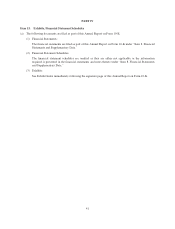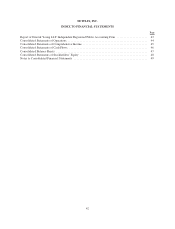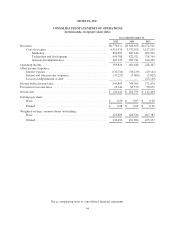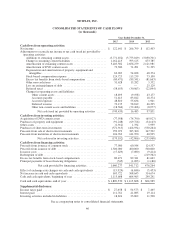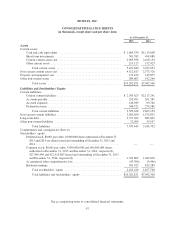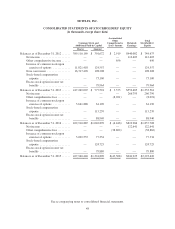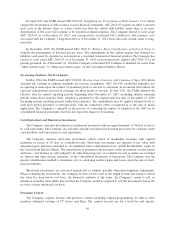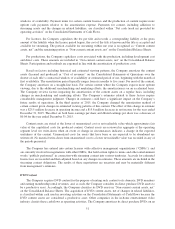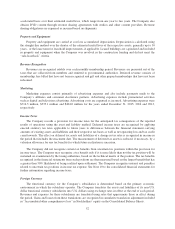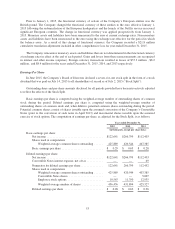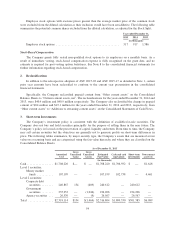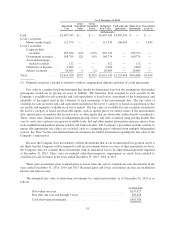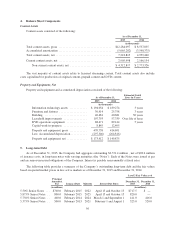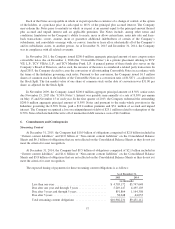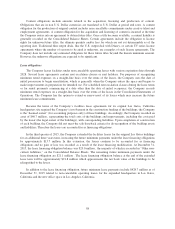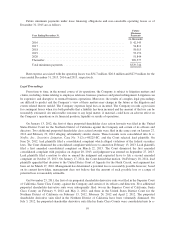NetFlix 2015 Annual Report Download - page 53
Download and view the complete annual report
Please find page 53 of the 2015 NetFlix annual report below. You can navigate through the pages in the report by either clicking on the pages listed below, or by using the keyword search tool below to find specific information within the annual report.NETFLIX, INC.
NOTES TO CONSOLIDATED FINANCIAL STATEMENTS
1. Organization and Summary of Significant Accounting Policies
Description of Business
Netflix, Inc. (the “Company”) was incorporated on August 29, 1997 and began operations on April 14,
1998. The Company is the world’s leading Internet television network with over 75 million streaming members
in over 190 countries enjoying more than 125 million hours of hours of TV shows and movies per day, including
original series, documentaries and feature films. Members can watch as much as they want, anytime, anywhere,
on nearly any Internet-connected screen. Members can play, pause and resume watching, all without
commercials or commitments. Additionally, in the United States (“U.S.”), members can receive DVDs.
The Company has three reportable segments, Domestic streaming, International streaming and Domestic
DVD. A majority of the Company’s revenues are generated in the United States, and substantially all of the
Company’s long-lived tangible assets are held in the United States. The Company’s revenues are derived from
monthly membership fees.
Basis of Presentation
The consolidated financial statements include the accounts of the Company and its wholly-owned
subsidiaries. Intercompany balances and transactions have been eliminated.
Use of Estimates
The preparation of consolidated financial statements in conformity with accounting principles generally
accepted in the United States of America requires management to make estimates and assumptions that affect the
reported amounts of assets and liabilities, disclosure of contingent assets and liabilities at the date of the financial
statements, and the reported amounts of revenues and expenses during the reporting periods. Significant items
subject to such estimates and assumptions include the amortization policy for the streaming content assets; the
recognition and measurement of income tax assets and liabilities; and the valuation of stock-based compensation.
The Company bases its estimates on historical experience and on various other assumptions that the Company
believes to be reasonable under the circumstances. Actual results may differ from these estimates.
Stock Split
On July 14, 2015, the Company completed a seven -for-one stock split in the form of a stock dividend.
References made to outstanding shares or per share amounts in the accompanying consolidated financial
statements and applicable disclosures have been retroactively adjusted to reflect this seven -for-one stock split.
The number of authorized shares as reflected on the Consolidated Balance Sheets was not affected by the stock
split and accordingly has not been adjusted. See Note 8 for additional information.
Accounting Guidance Adopted in 2015
In April 2015, the Financial Accounting Standards Board (“FASB”) issued Accounting Standards Update
(“ASU”) 2015-05, Customer’s Accounting for Fees Paid in a Cloud Computing Arrangement, which provides
guidance to customers about whether a cloud computing arrangement includes a software license. If a cloud
computing arrangement includes a software license, the customer should account for the software license element
of the arrangement consistent with the acquisition of other software licenses. If the arrangement does not include
a software license, the customer should account for a cloud computing arrangement as a service contract. The
Company elected to early adopt the ASU in the third quarter of 2015 and has applied the guidance prospectively
to all arrangements. The impact of the adoption of the ASU was not material to the Company’s consolidated
financial statements.
49




